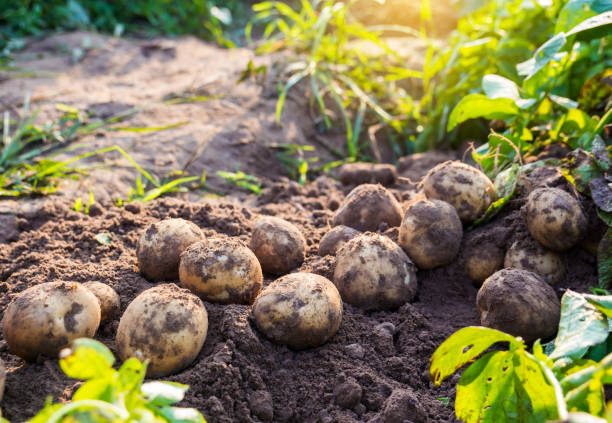
Potatoes are easy to grow, especially when you know the secret. But the biggest reward, of course, comes from harvesting them at the right time.
When are potatoes ready to harvest?
Here’s a quick glance to determine when your potatoes are ready for harvest:
| Signs | Description | |
| Flowers | The appearance of flowers indicates potatoes should be checked for maturity, although not all cultivars will bloom. | Image on istockphoto by Dragomira |
| Leaves | When your plants die back with yellow leaves, your potatoes are ready to be checked for harvesting. | Image on istockphoto by Pham Hung |
| Date of Maturity | The date of maturity of the potato cultivars you are growing should also allow you to estimate their harvest time. | Early-harvest potato cultivars generally take around 90 days from planting to harvest. Mid-harvest potato cultivars usually go for 110 days before they are mature. Maincrop potato cultivars typically take about 135 days to harvest. |
Now, let’s get into more detail.
How to identity potatoes for harvest
Potatoes come in three types: first earlies, second earlies, and maincrop potatoes. These categories are according to when they are sown and harvested.
| Type | Period of Maturation | Sowing and Harvesting Dates |
| First earlies / Early-harvest cultivars | Around 90 days | Sowing: Around late March Harvesting: June or July |
| Second earlies / Mid-harvest cultivars | 110 days | Sowing: Mid-April Harvesting: July to August |
| Maincrop cultivars | Around 135 days | Sowing: Around late April Harvesting: August to October |
Generally, mature potatoes will have thick skins attached firmly to their flesh. However, you should note that some potato cultivars naturally have thin skins, such as Round Reds, Yellows, and Whites.
If you plan to eat them at this stage, remove all sprouts completely. These contain several toxins that can possibly harm your body.

Signs your potatoes are ready for harvest
There are several indications that your potatoes are on their way to maturity. Even with different varieties, one or both of the two signs will typically be the same.
Here are three ways to spot the maturity of your potatoes:
Flowers
When flowers appear, this is an indication that your potatoes are ready for harvest. You will have to note though that not all varieties will produce flowers.
How to harvest:
When your potatoes do start to flower, you can wait two weeks before harvesting them. Simply reach underneath the ground to feel for potatoes that can be easily detached to avoid unnecessary damage to the mother plant.
Typically, harvested immature tubers will be around two inches in diameter with thin papery skin. The great thing about these types of potatoes is that you can still eat them with the skin on.
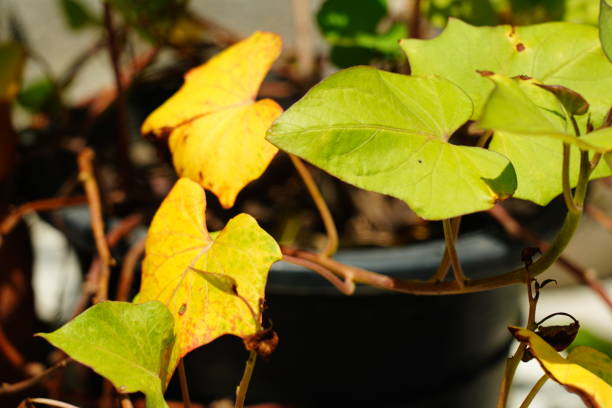
Leaves
The presence of healthy leaves is usually a great indicator of growth. But when your potatoes start to exhibit yellowing, wilting, and dying back, these could be indicators that they are ready for harvest.
How to harvest:
Before you dig into the soil, make sure that the yellowing and wilting leaves are not the results of blight (row 365 – can you eat potatoes with blight). Blight usually happens during periods of heavy rain.
Symptoms of potato blight
Before you panic, check for some signs of potato blight:
- Watery rotting spots on potato leaves
- These affected leaves eventually shrivel and turn brown
- Brown lesions may spread to the stems
When left alone, potato blight can affect your entire crop. Unfortunately, there are no available chemical treatments for potato blight.
Dealing with potato blight
The ideal approach is to simply dig up the affected plants and dispose of them safely. Blight usually occurs during wet summers when the rain and the hot temperature encourage fungal spores to grow and spread.
Luckily, you can always check your area’s history of blight to predict any possible risks. Additionally, first earlies are generally spared from potato blight.
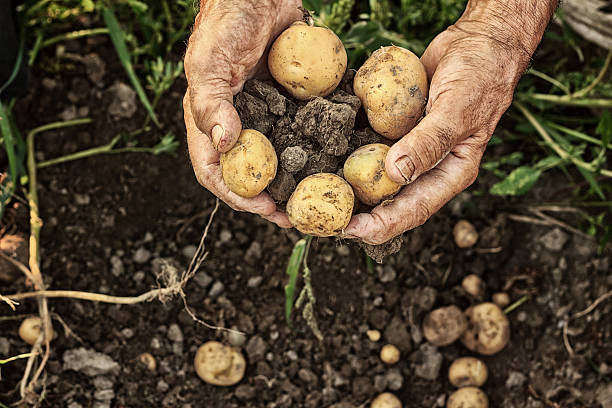
Date of Maturity
As mentioned earlier, your most obvious indication will be the type of potato cultivar you have grown and its corresponding time of harvest. Here is a quick recap:
| Potato Cultivar Types | Number of Days after Planting to Harvest |
| Early Harvest Cultivars | 90 days to harvest |
| Mid-Harvest Cultivars | 110 days to harvest |
| Maincrop Cultivars | 135 days to harvest |
WILDCARD: Temperature
There are also other considerations aside from the flowering, the foliage conditions, and the dates of maturity. This is where your local weather conditions come in.
Your climate plays an important role in the maturity of your potatoes. Cold weather tends to delay the harvest time of most plants including potatoes.
You can mark the day your potatoes were sown in order to determine the number of days that have passed. Once the day nears, check your potato plants frequently to determine if they are ready for harvest.
Here’s how to do it:
- Turn over the soil to check for loose tubers.
- Take one out.
- Check it for maturity.
- Look for thick skin with firm flesh.
- Either return them to the ground or consume them.
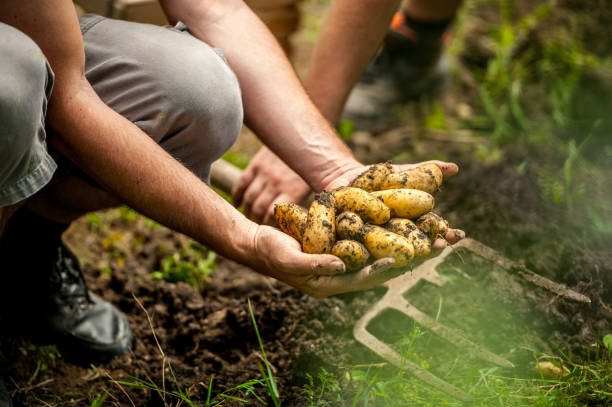
How to Harvest Your Potatoes
There are basically two ways you can harvest your potatoes. You can use one exclusively or try each method to see which one suits you best.
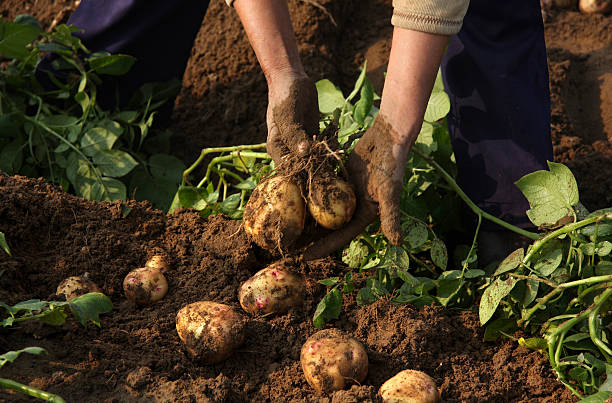
Image on istockphoto by enter89
1. Using your hands
Your hands are the best harvesting tools if your garden area for potatoes is small. Potatoes that are grown in grow bags, buckets, or raised beds are ideal for harvesting by hand.
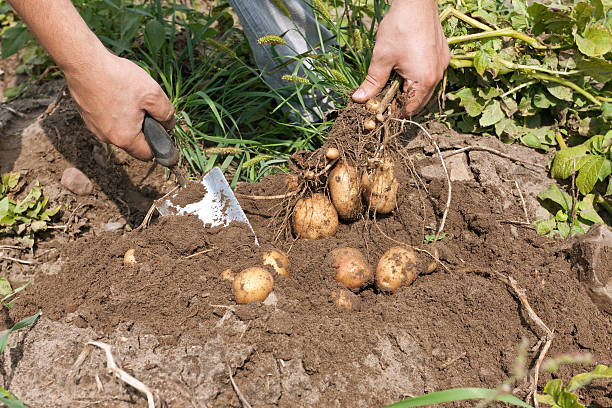
2. Using digging tools
Tools such as hand trowels or spading forks are perfect to use if the soil is heavier and more compact. If your soil is light and fluffy, you can easily look for potatoes using your hands.
Harvesting Potatoes in Grow Bags and Buckets
Here’s how you can easily harvest your potatoes that have been growing in containers:
- Take your potted potato plants and turn them upside down.
- Use a wheelbarrow or burlap to catch the soil from the containers.
- Remove the containers once your potato plants are upside down. The contents should show all the potato tubers growing in the potting soil.
- Sift through the soil and pick out the potatoes.
- Either put the soil back in your containers or use them in your garden. Alternatively, the soil can be added to your compost pile.
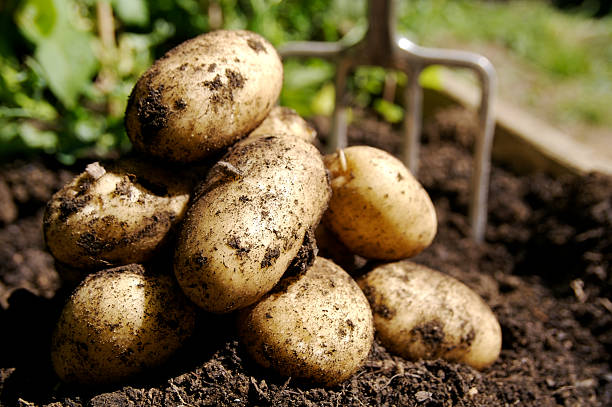
Harvest Potatoes from Raised Beds
Raised beds are another easy way to get mature potatoes. Here’s how you can do it:
- Check your soil if it’s light and fluffy or heavy and more compacted.
- For light and fluffy soils: reach inside, root around to feel for tubers, and remove those that are clearly mature.
- For heavier and more compacted soil: use a digging tool such as a hand trowel or a spading fork to loosen the soil.
- Prod the soil lightly to prevent damaging potato tubers.
- Once you feel that you are near some, loosen the soil with your hands.
- As before, gently remove the potatoes that are clearly mature for harvest.
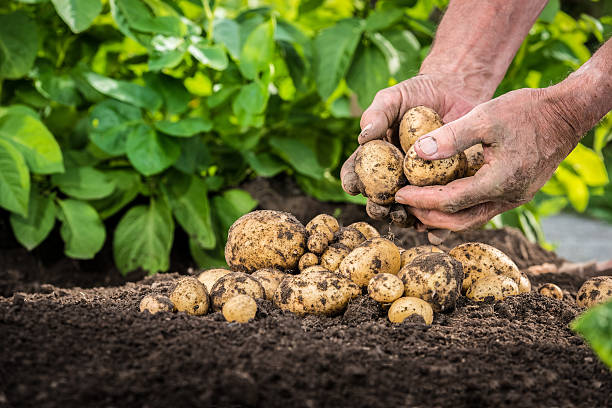
FAQs on growing and harvesting potatoes
It is not recommended to leave potatoes in the ground too long. The soil may eventually become conducive to potato rot.
Alternatively, potatoes left in the ground too long can start to sprout again. This means that you will not be able to harvest them once they start growing leaves.
It is possible to dig your potatoes up before flowering but the harvest will not be as good as if you left them after the flowers and leaves die off. If possible, wait for your potato plants to display the ideal signs for harvesting.
You can definitely eat freshly-dug potatoes, although you should clean them thoroughly before cooking them. However, it is still best to allow them to cure at 45 to 60 Fahrenheit for about two weeks with 85 to 95 percent humidity.
Excess nitrogen causes your potato tuber to bulk and decreases its potato production. This is because nitrogen promotes foliage growth rather than flower or fruit production.
Generally, a productive potato plant can yield anywhere from 5 to 10 healthy potatoes. However, each cultivar can vary in terms of harvest.
That’s it! We hope this article will be of great use to you. Let us know in the comments section if you have more useful tips on harvesting potatoes!




